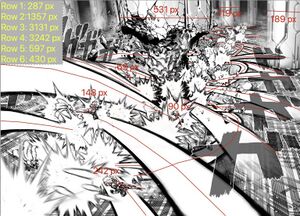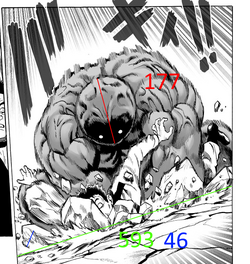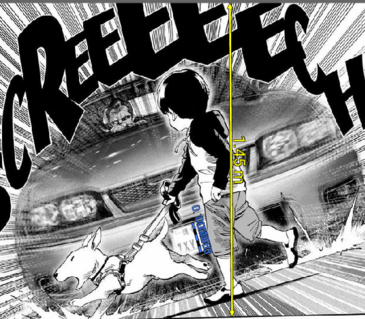
The official discord link if you wish to join the discord: https://discord.gg/j5RKwCvAFu
Support the wiki on our official Ko-Fi page or Patreon page!
User:GiverOfThePeace/One-Punch Man Calculations: Difference between revisions
From The Codex
| (9 intermediate revisions by the same user not shown) | |||
| Line 1: | Line 1: | ||
==Introduction== | ==Introduction== | ||
This will be a compilation of calculations in One-Punch Man. | This will be a compilation of calculations in One-Punch Man. | ||
==Young Saitama gets hit into a wall== | |||
In [[One-Punch Man]], a young [[Saitama]] gets hit by a wall causing a massive crack around it. | |||
===Calculation=== | |||
[[File:Saitama's_Durability.jpg|thumb|340px]] | |||
Soda Can Length = 42 px = [https://www.reference.com/food/dimensions-soda-can-61aa07386abce28f 12.27 cm] | |||
Crater Diameter = 306 px = 89.40 cm | |||
Crater Radius = 44.7 cm | |||
Crater Depth = 25.4 cm ([http://shootingthebull.net/blog/if-a-chests-only-10-thick/ The average human's chest thickness is 10″]) | |||
I'll treat the crater as a half-ellipsoid. | |||
Volume = 2/3*pi*44.7*44.7*25.4 = 106293.66 cc | |||
Assuming concrete, [[User:MrWarnerTheGreat/Sandbox9#Concrete|the toughness value for concrete is 0.4 j/cc]]. | |||
Formula is: | |||
((Total Volume(V¹) * (Percentage reduction(V²)) * Fracture Toughness(F) | |||
Percentage reduction assumed to be 70% if not shown or stated otherwise | |||
((106293.66 cc) * (70%)) * (0.4 j/cc) = '''2.97622248e4 Joules''', '''Wall level''' | |||
==During Training Saitama Car Speed== | |||
In [[One-Punch Man]], [https://imgur.com/a/5T0WY9N a Saitama in training saves Tareo and his pet from a car that was very close to running over them]. | |||
===Calculation=== | |||
<tabber> | |||
|-|Scan 1=[[File:Screenshot 2018-09-02-15-25-06-1.png|right|365px]] | |||
|-|Scan 2=[[File:Screenshot 2018-09-02-15-29-16-1.png|right|365px]] | |||
|-|Scan 3=[[File:Screenshot 2018-09-02-15-24-17-1.png|right|365px]] | |||
|-|Scan 4=[[File:Screenshot 2018-09-02-15-25-29-1.png|right|365px]] | |||
</tabber> | |||
First, we need to calculate the distance between Saitama and Tareo, because that is the distance that Saitama ran to save him. | |||
Scan 1 | |||
Saitama = 175 cm or 1.75 m | |||
Panel Height = 5.99 m | |||
Distance = 1.75*5.99/[1.75*2tan(70/2)] = '''4.27 m''' | |||
After that, we have to measure the length Tareo's head. | |||
Scan 2 | |||
Garou = 177 cm | |||
Tareo's Head = 21.59 cm | |||
Then we have to measure the distance between Tareo and the car. | |||
Scan 3 | |||
License plate = [https://images.summitmedia-digital.com/topgear/images/articleImages/news/0_2013/08/15/new_license_plates/1-private-mv.jpg 140 mm or 0.14 m] | |||
'''Panel Height''' = 1.45 m | |||
Distance = 0.14*1.45/[0.14*2tan(70/2)] = '''1.04 m''' | |||
That's the distance between the license plate and the field of view, now we have to find the distance between Tareo and the field of view. | |||
Scan 4 | |||
Tareo's Head = 21.59 cm or 0.2159 m | |||
Panel Height = 1.27 m | |||
Distance = 0.2159*1.27/[0.2159*2tan(70/2)] = '''0.91 m''' | |||
Now to obtain the distance between the car and Tareo, we need to subtract the two previously calculated distances. | |||
Distance = 1.04 - 0.91 = 0.13 m | |||
With that distance we can find the timeframe. The general speed limit in Japan is 60 km/h or 16.6667 m/s, so I'm going to assume the car was moving at that speed. | |||
Timeframe = 0.13/16.6667 = '''0.0077999844000312 seconds''' | |||
Finally we can find Saitama's speed. | |||
Speed = 4.27/0.0077999844000312 = '''547.44 m/s''' or '''Supersonic''' | |||
==Vaccine Man Databook== | |||
[https://drive.google.com/file/d/1Z7_xJ1g9REBg2PCSxAWOVCK5DMGrKM9x/view?usp=sharing Vaccine Man's databook notes that he gathers bio-energy from the earth and releases it, creating explosions that can pulverize high-rise buildings]<ref>One-punch Man Hero Encyclopedia Pages 102-103</ref>. | |||
===Calculation=== | |||
To estimate the energy required for Vaccine Man's blasts to pulverize entire high-rise buildings, we'll break down the problem into several steps. | |||
'''Step 1: Size of the Building''' | |||
<br> | |||
Assume a typical high-rise building [https://en.wikipedia.org/wiki/Skyscraper has a height of 100 meters] and a base area of 40 meters by 40 meters. The volume of the building can be calculated as: | |||
Volume = Height × Base Area = 100m × 40m × 40m = 160,000m<sup>3</sup> | |||
'''Step 2: Material and Mass''' | |||
<br> | |||
Assume the building is made of reinforced concrete and steel, with the following densities: | |||
Reinforced Concrete Density: [https://en.wikipedia.org/wiki/Properties_of_concrete#:~:text=The%20density%20of%20concrete%20varies,of%20various%20materials%20are%20available. 2400 kg/m³] | |||
Steel Density: [https://buyabeam.com/blogs/steel-beams/what-makes-steel-so-dense/#:~:text=What%20is%20the%20Density%20of%20Steel%3F&text=Plain%20steel%20has%20a%20density,depending%20on%20your%20preferred%20measurements. 7850 kg/m³] | |||
Assume the building is composed of 80% concrete and 20% steel by volume. The mass of the concrete and steel in the building can be calculated as: | |||
Mass of Concrete = 160,000m<sup>3</sup> × 0.8 ×2400kg/m<sup>3</sup> = 307,200,000 kg | |||
Mass of Steel= 160,000m<sup>3</sup> × 0.2 × 7850kg/m<sup3</sup> = 251,200,000 kg | |||
'''Step 3: Energy Required to Pulverize''' | |||
<br> | |||
The specific energy required to pulverize the materials is: | |||
Concrete Pulverization Energy: 10<sup>6</sup>J/m<sup>3</sup> ([https://www.academia.edu/39219169/Concrete_and_Masonry_Databook "Concrete and Masonry Databook" by Christine Beall] and "Recycling of Demolished Concrete and Masonry" edited by T.C. Hansen both list energy requirements for crushing concrete, falling within the range of 1 to 10 MJ/m³) | |||
Steel Pulverization Energy: 10<sup>8</sup>J/m<sup>3</sup> (Steel is significantly harder to pulverize compared to concrete, requiring much higher energy due to its tensile strength and ductility. The value of ~10^8 J/m³ can be estimated based on the energy required for high-intensity processes like ball milling or other forms of mechanical alloying, where steel is broken down into fine particles. "Introduction to the Mechanical Behavior of Steel" by G. Krauss and "Mechanical Alloying And Milling" by C. Suryanarayana go further into this) | |||
'''Step 4: Total Energy''' | |||
<br> | |||
The total energy required to pulverize the concrete and steel can be calculated as: | |||
Energy for Concrete = 307,200,000 kg × 10<sup>6</sup>J/m<sup>3</sup> = 3.072×10<sup>14</sup>J | |||
Energy for Steel = 251,200,000 kg × 10<sup>8</sup>J/m<sup>3</sup> = 2.512×10<sup>16</sup>J | |||
Adding these together gives the total energy required: | |||
Total Energy = 3.072×10<sup>14</sup>J + 2.512×10<sup>16</sup>J = 2.54272×10<sup>16</sup>J or 6.0772466539196940971 Megatons of TNT, '''7-B'''. | |||
==Mosquito Girl's Mosquitoes Speed== | ==Mosquito Girl's Mosquitoes Speed== | ||
[https://drive.google.com/drive/folders/15xWxJBfTQCCU8SIpL6iUeV-R48WnfMth?usp=sharing Mosquito Girl calls her mosquitoes from a 50 kilometer radius and they all reach her within a short timeframe]<ref>One-Punch Man House of Evolution Arc</ref>. | [https://drive.google.com/drive/folders/15xWxJBfTQCCU8SIpL6iUeV-R48WnfMth?usp=sharing Mosquito Girl calls her mosquitoes from a 50-kilometer radius and they all reach her within a short timeframe]<ref>One-Punch Man House of Evolution Arc</ref>. | ||
===Calculation=== | ===Calculation=== | ||
We have | We have the distance, now we just need the timeframe, using the anime for this, she calls her mosquitoes at 7:21 and a large amount of them reach her at 7:30, you can find this in One-Punch Man Season 1 Episode 2. | ||
So that is 9 seconds. | So that is 9 seconds. | ||
| Line 13: | Line 142: | ||
V = (50000 meters)/(9 seconds) = 5555.5555555555555556 m/s or Mach 16.196954972465178457, '''High Hypersonic''' | V = (50000 meters)/(9 seconds) = 5555.5555555555555556 m/s or Mach 16.196954972465178457, '''High Hypersonic''' | ||
==Genos Causes Big Boom== | |||
[https://ibb.co/album/jvS7fR?sort=name_asc Genos caused a massive blast], [https://youtu.be/hdj9MjRkfQc?t=156 resulting in a massive explosion]<ref>One-Punch Man Episode 2</ref> [https://ibb.co/ckMVMfh with him being able to fire these blast out of a 500-meter radius]<ref>One-Punch Man House of Evolution Arc</ref>. | |||
===Calculation=== | |||
So a ground explosion formula would be pretty easy to use here since we visibly see the ground is burned from this. | |||
W = Radius is meters^3*((27136*1.37895+8649)^(1/2)/13568-93/13568)^2 | |||
W = 500^3*((27136*1.37895+8649)^(1/2)/13568-93/13568)^2 | |||
W = 10046.0544623238495038 Tons of TNT or 10.046054462323848355 Kilotons of TNT, aka '''Town level'''. | |||
==Genos Destroys House of Evolution== | |||
[https://ibb.co/album/9ntxGX?sort=name_asc Genos straight up nukes the house of evolution with a blast so powerful it destroys a part of several mountains]<ref>One-Punch Man House of Evolution Arc</ref>. | |||
===Calculation=== | |||
This one is hard to decide since there are no accurate measurements anywhere here. For a safer assumption, it looks like it vaporized the entire 8-story house of evolution and the mountains show further vaporization occurred. | |||
On top of this, [https://youtu.be/dgYOE4kPTTk?t=24 the anime shows the entire area cratered]. | |||
So with this, we can use [[Reference for Common Feats]] vaporization of a building and replace it with an 8-story building end. | |||
[https://en.wikipedia.org/wiki/Housing_in_Japan Wikipedia] states that the average size of an owned residence in Japan is 121.7 m^2. When you think "average house/ building" you have in mind a two-storey building, which is approx 6.6 m. We'll thus assume 3.3 per story, making it 26.4 meters. | |||
Putting these together gives us a volume of 3,212.88 m^3. The density of concrete is 2400 kg per cubic meter. So 7,710,912 kg = 7,710,912,000 g. | |||
Using the formula Q = m*c*ΔΤ | |||
Using 3 ends of 80%, 85% and 90% hollowness for the mass. | |||
[https://www.designingbuildings.co.uk/wiki/Specific_heat_capacity#:~:text=Concrete%3A%20880%20J%2Fkg%C2%B0C Concrete's specific heat capacity is 880 J/kg°C]. | |||
Change in temperature is from room temperature to concrete's melting point: | |||
Concrete's melting point = [https://bagofconcrete.com/what-is-the-melting-point-of-concrete/#:~:text=Nevertheless%2C%20by%20rough%20approximation%2C%20the,is%20approximately%201%2C550%20degrees%20Celsius. 1500 °C]. | |||
Room temperature = 20 °C (average of 15 °C and 25 °C) | |||
High end: 80% hollowness: 7,710,912,000g * 0.2 * 880J/kg°C * (1500°C - 20°C) = 2.00853835776e15 J = 480.0521887571701996kilotons of tnt. ('''Town level''') | |||
Mid end: 85% hollowness: 7,710,912,000g * 0.15 * 880J/kg°C * (1500°C - 20°C) = 1.50640376832e15 J = 360.039141567877607 kilotons of tnt. ('''Town level''') | |||
Low end: 90% hollowness: 7,710,912,000g * 0.1 * 880J/kg°C * (1500°C - 20°C) = 1.00426917888e15 J = 240.0260943785850998 kilotons of tnt. ('''Town level''') | |||
This is technically a lowballed calc since it's not taking into account the mountains having partly vaporized holes on them but there's not much I can do for those since we have no way of getting accurate measurements for them. Plus I'm pretty sure the amount of the area vaporized in the mountain would net Town level also anyway. | |||
==Giant Meteor KE== | |||
This calc is pretty simple, we have a span for the Giant Meteor, now we will calculate the kinetic energy of it crashing. | |||
===Calculation=== | |||
[https://drive.google.com/file/d/13ApEghu4xDUI_8aix7ctrh4gkA0HulOG/view?usp=sharing Giant Meteor has a span of 200 meters]<ref>One-Punch Man Hero Encyclopedia Pages 136-137</ref>. | |||
Meteors are spherical shaped, so we will be using that volume for it. | |||
V = (4/3)πr^3 | |||
V = 4.19e6 m^3 or 4.19e+12 cm^3 | |||
Now for density, the meteor is noted to be made of special material, so we'll just assume a material like iron-nickel alloy since that's common in meteorites. | |||
[https://www.lesker.com/newweb/deposition_materials/deposition-materials-notes.cfm?pgid=ni4#:~:text=It%20has%20a%20density%20of%207.86%20g%2Fcc%2C%20a%20melting,alloy%20is%208.7%20g%2Fcc. Its density is 7.86 g/cc]. | |||
M = V * D | |||
M = 4.19e+12 cc * 7.86 g/cc | |||
M = 3.29334e13 g 3.29334e10 kg | |||
[https://education.nationalgeographic.org/resource/meteor/ The fastest meteors travel through space at speeds of 71 kilometers per second] or 71000 m/s. | |||
Plugging this into the KE calculator: | |||
KE = 1/2mv^2 | |||
KE = 8.30086347E+19 Joules or 19.839539842256215252 Gigatons of TNT, '''Island level'''. | |||
No one to really scale it to since some of the mid-ranking S Class heroes couldn't destroy it and only [[Saitama]] did. | |||
==Deep Sea King Blitzes Lightning Max== | |||
[https://drive.google.com/drive/folders/1CIFM9XufuGOffSDAhveTvNDRLqwmamuu?usp=sharing Deep Sea King appears behind Lightning Max without him even noticing]<ref>One-Punch Man Sea Monsters Arc</ref>. Lightning Max was on top of a building too. | |||
===Calculations=== | |||
[https://en.wikipedia.org/wiki/Tower_block#:~:text=In%20the%20U.S.%2C%20the%20National,at%20least%2075%20feet%20tall. The kind of building lightning max was on is typically defined as being at least 75 meters in height]. | |||
As he had an entire conversation before Deep Sea King got there, that was the timeframe I used, using a timer I got around 2-3 seconds, using 3 seconds since Lightning Max did briefly pause. | |||
75m/3s = 25 m/s or '''Superhuman'''. | |||
Calculation is obviously lowballed since the building could've been much taller, but this is the safest assumption. | |||
==Speed o' Sound Sonic and Rain Drops== | |||
[https://drive.google.com/file/d/1Y6K4VfSDxfkoY3bXu8p-kEuyKDK0kVLc/view?usp=sharing In his fight with Deep Sea King, he was moving so fast that the rain drops moved slowly]<ref>One-Punch Man Episode 8</ref>. | |||
===Calculation=== | |||
So we must use a reference calculator for this, the slow-motion calc! We'll give Sonic the average human running speed for the apparent speed of the object of interest since he's not walking during the slow-motion moments, which we list as 5 m/s on the speed page. | |||
(real speed of reference object / apparent speed of reference object) * apparent speed of object of interest = real speed of object of interest | |||
(10 m/s / 0.1 m/s) * 5 = 500 m/s or '''Supersonic'''. | |||
The reason for not measuring things like how far the raindrops traveled while they were moving is because the scene keeps constantly shifting and there's no real good metric of measurement to get here. | |||
==Near Light Speed Pebble Throw== | ==Near Light Speed Pebble Throw== | ||
| Line 18: | Line 246: | ||
===Calculation=== | ===Calculation=== | ||
In this case, he specifically means rocks. Now due to how the sizes of each are decently large, I'll use [https://rockhoundresource.com/how-much-do-rocks-weigh-pictures-examples-calculations/ this site] for a basic weigh of rocks, which on average a cubic foot of rock weighs 165.2 pounds. | In this case, he specifically means rocks. Now due to how the sizes of each are decently large, I'll use [https://rockhoundresource.com/how-much-do-rocks-weigh-pictures-examples-calculations/ this site] for a basic weigh of rocks, which on average a cubic foot of rock weighs 165.2 pounds (74.933459524 kg). | ||
As they are using near light speed/sub-light along with noting the reason it can do this is that the friction between the rock and air is removed, we'll assume 99% the speed of light for this. The anime further supports this since Gery [https://www.youtube.com/watch?v=1XijoLrAdM8&feature=youtu.be&t=22 can make gravity so intense, it's equivalent to a black hole]<ref>One-Punch Man Season 1 Episode 11</ref>. | As they are using near light speed/sub-light along with noting the reason it can do this is that the friction between the rock and air is removed, we'll assume 99% the speed of light for this. The anime further supports this since Gery [https://www.youtube.com/watch?v=1XijoLrAdM8&feature=youtu.be&t=22 can make gravity so intense, it's equivalent to a black hole]<ref>One-Punch Man Season 1 Episode 11</ref>. | ||
So this is a RKE calculation, [https://www.omnicalculator.com/physics/relativistic-ke using this calculator], I get the result of 4.1006221931307569e19 Joules or 9.8007222589167248827 Gigatons of TNT, '''Island level'''. | So this is a RKE calculation, [https://www.omnicalculator.com/physics/relativistic-ke using this calculator], I get the result of 4.1006221931307569e19 Joules or 9.8007222589167248827 Gigatons of TNT, '''Island level'''. | ||
While I'm at it, lemme find newtons behind this too. | |||
F = ma | |||
F = (74.933459524 kg)*(2.968e+8 m/s^2) | |||
F = 2.2240250786723e10 Newtons or '''Class G''' | |||
==Hammerhead Collapses a Skyscraper== | |||
So initially I just linked to my average calc for destroying a skyscraper, but that assumes you caused an explosion or pulverized it, in this case, [https://drive.google.com/drive/folders/1Yn1wia_gOz_8u_mJeM-_Ca-weTGgaBIA?usp=sharing this is him causing one to collapse from a single punch]<ref>One-Punch Man Paradise Group Arc</ref>, so it's actually a different method. | |||
===Calculation=== | |||
We'll be using '''Gravitational Potential Energy''' for this one. | |||
U=m g h | |||
Where | |||
<br> | |||
U = gravitational energy | |||
m = mass | |||
g = gravitational field | |||
h = height | |||
'''Step I: Mass of the Building''' | |||
<br> | |||
Assume a typical high-rise building [https://en.wikipedia.org/wiki/Skyscraper has a height of 100 meters] and a base area of 40 meters by 40 meters. The volume of the building can be calculated as: | |||
Volume = Height × Base Area = 100m × 40m × 40m = 160,000m<sup>3</sup> | |||
Assume the building is made of reinforced concrete and steel, with the following densities: | |||
Reinforced Concrete Density: [https://en.wikipedia.org/wiki/Properties_of_concrete#:~:text=The%20density%20of%20concrete%20varies,of%20various%20materials%20are%20available. 2400 kg/m³] | |||
Steel Density: [https://buyabeam.com/blogs/steel-beams/what-makes-steel-so-dense/#:~:text=What%20is%20the%20Density%20of%20Steel%3F&text=Plain%20steel%20has%20a%20density,depending%20on%20your%20preferred%20measurements. 7850 kg/m³] | |||
Assume the building is composed of 80% concrete and 20% steel by volume. The mass of the concrete and steel in the building can be calculated as: | |||
Mass of Concrete = 160,000m<sup>3</sup> × 0.8 ×2400kg/m<sup>3</sup> = 307,200,000 kg | |||
Mass of Steel= 160,000m<sup>3</sup> × 0.2 × 7850kg/m<sup3</sup> = 251,200,000 kg | |||
Total Mass = 307,200,000 kg + 251,200,000 kg | |||
Total Mass = 558,400,000 kg | |||
'''Step II: Gravitational Field''' | |||
<br> | |||
This one is easy, [https://en.wikipedia.org/wiki/Gravity_of_Earth#:~:text=Near%20Earth%27s%20surface%2C%20the%20acceleration,ft%2Fs)%20every%20second. acceleration due to gravity on Earth is 9.8 m/s<sup>2</sup>]. | |||
'''Step III: Height''' | |||
<br> | |||
Assume a typical high-rise building [https://en.wikipedia.org/wiki/Skyscraper has a height of 100 meters]. | |||
'''Step IV: Formula''' | |||
U=m g h | |||
U = (558,400,000 kg) * (9.8 m/s<sup>2</sup>) * (100 m) | |||
U = 5.47232e11 Joules or 130.791586998088 Tons of TNT, '''8-A'''. | |||
Should also be noted since his physical strength outright overpowered the pass and caused it to topple, this would apply to his lifting strength, and since the mass is 558,400,000 kg, that's '''Class M'''. | |||
I'll move this to the standard for destroying a skyscaper also since this is pretty common with skyscraper feats. | |||
==Boros Kicks Saitama to the Moon== | ==Boros Kicks Saitama to the Moon== | ||
| Line 109: | Line 397: | ||
Speed = 127.74/0.12 = '''1532.88 m/s''' or '''Mach 4.469037901''', '''Supersonic+'''. | Speed = 127.74/0.12 = '''1532.88 m/s''' or '''Mach 4.469037901''', '''Supersonic+'''. | ||
==Surprise Attack Plum Crushes Cop== | |||
In [[One-Punch Man]], [https://imgur.com/a/zdLRbeV a police officer gets buried in the ground by the monster Plum]. | |||
===Calculation=== | |||
'''Scan 1''' | |||
[[File:Plum_Head_Size.png|right|250px]] | |||
Plum Height = 400 cm (239 px) | |||
Plum Head = 113.807531381 cm (68 px) | |||
'''Scan 2''' | |||
[[File:Officer_Buried.png|right|250px]] | |||
Plum Head = 113.807531381 cm (177 px) | |||
Crater Diameter = 381.287379147 cm (593 px) | |||
Axis A = '''190.643689573 cm''' | |||
For Axis B, I'll use the average height for an [http://nbakki.hatenablog.com/entry/2014/05/26/192451 18 year old Japanese male as the diameter.] | |||
Axis B = '''85.4 cm''' | |||
Crater Height = '''29.577098551 cm''' (46 px) | |||
[https://keisan.casio.com/exec/system/15380992152819 Volume] = 1512814.7359617 cc | |||
[https://staticworx.com/faq/laboratory-flooring/ Apparently material like rubber is used in laboratories]. | |||
[[User:MrWarnerTheGreat/Sandbox9#Rubber|Rubber is 1.85 J/cc]]. | |||
Formula is: | |||
((Total Volume(V¹) * (Percentage reduction(V²)) * Fracture Toughness(F) | |||
Percentage reduction assumed to be 70% if not shown or stated otherwise | |||
((1512814.7359617 cc) * (70%)) * (1.85 J/cc) = '''1.9590950830704015e6 Joules''' or '''Wall level''' | |||
==Gigaki-Gan Stored Energy for Over a Thousand years== | ==Gigaki-Gan Stored Energy for Over a Thousand years== | ||
| Line 161: | Line 486: | ||
(214.57011494252871131m)/(0.1s) = 2145.7011494252871131 m/s or '''Mach 6.255688482289466279'''. | (214.57011494252871131m)/(0.1s) = 2145.7011494252871131 m/s or '''Mach 6.255688482289466279'''. | ||
However, we have a better timeframe for this. In this same scene, the guy notes [https://drive.google.com/file/d/1FBDkVlgICWShrrvU_Ghh4-GslN0EUFMK/view?usp=sharing he draws his sword faster than sound], and Atomic Samurai moved so fast he couldn't perceive it at all. Now faster than sound is the bare minimum '''Transonic''', so this will be the assumption. Using the '''[[Reactions]]''' page, Transonic perception is '''3.64e-3 to 2.78e-3 seconds'''. | However, we have a better timeframe for this. In this same scene, the guy notes [https://drive.google.com/file/d/1FBDkVlgICWShrrvU_Ghh4-GslN0EUFMK/view?usp=sharing he draws his sword faster than sound]<ref>One-Punch Man Super Fight Arc</ref>, and Atomic Samurai moved so fast he couldn't perceive it at all. Now faster than sound is the bare minimum '''Transonic''', so this will be the assumption. Using the '''[[Reactions]]''' page, Transonic perception is '''3.64e-3 to 2.78e-3 seconds'''. | ||
(214.57011494252871131m)/(3.64e-3s) = 58947.83377541997563461538 m/s or Mach 171.85957368927105904, '''Massively Hypersonic'''. | (214.57011494252871131m)/(3.64e-3s) = 58947.83377541997563461538 m/s or Mach 171.85957368927105904, '''Massively Hypersonic'''. | ||
| Line 168: | Line 493: | ||
{{scroll box|content={{reflist|2}}}} | {{scroll box|content={{reflist|2}}}} | ||
[[Category:One Punch Man]] | [[Category:One-Punch Man]] | ||
[[Category:Calculations]] | [[Category:Calculations]] | ||
[[Category:Seinen]] | [[Category:Seinen]] | ||
[[Category:Blog posts]] | [[Category:Blog posts]] | ||
Latest revision as of 18:03, 6 September 2024
Introduction
This will be a compilation of calculations in One-Punch Man.
Young Saitama gets hit into a wall
In One-Punch Man, a young Saitama gets hit by a wall causing a massive crack around it.
Calculation

Soda Can Length = 42 px = 12.27 cm
Crater Diameter = 306 px = 89.40 cm
Crater Radius = 44.7 cm
Crater Depth = 25.4 cm (The average human's chest thickness is 10″)
I'll treat the crater as a half-ellipsoid.
Volume = 2/3*pi*44.7*44.7*25.4 = 106293.66 cc
Assuming concrete, the toughness value for concrete is 0.4 j/cc.
Formula is: ((Total Volume(V¹) * (Percentage reduction(V²)) * Fracture Toughness(F)
Percentage reduction assumed to be 70% if not shown or stated otherwise
((106293.66 cc) * (70%)) * (0.4 j/cc) = 2.97622248e4 Joules, Wall level
During Training Saitama Car Speed
In One-Punch Man, a Saitama in training saves Tareo and his pet from a car that was very close to running over them.
Calculation
First, we need to calculate the distance between Saitama and Tareo, because that is the distance that Saitama ran to save him.
Scan 1
Saitama = 175 cm or 1.75 m
Panel Height = 5.99 m
Distance = 1.75*5.99/[1.75*2tan(70/2)] = 4.27 m
After that, we have to measure the length Tareo's head.
Scan 2
Garou = 177 cm
Tareo's Head = 21.59 cm
Then we have to measure the distance between Tareo and the car.
Scan 3
License plate = 140 mm or 0.14 m
Panel Height = 1.45 m
Distance = 0.14*1.45/[0.14*2tan(70/2)] = 1.04 m
That's the distance between the license plate and the field of view, now we have to find the distance between Tareo and the field of view.
Scan 4
Tareo's Head = 21.59 cm or 0.2159 m
Panel Height = 1.27 m
Distance = 0.2159*1.27/[0.2159*2tan(70/2)] = 0.91 m
Now to obtain the distance between the car and Tareo, we need to subtract the two previously calculated distances.
Distance = 1.04 - 0.91 = 0.13 m
With that distance we can find the timeframe. The general speed limit in Japan is 60 km/h or 16.6667 m/s, so I'm going to assume the car was moving at that speed.
Timeframe = 0.13/16.6667 = 0.0077999844000312 seconds
Finally we can find Saitama's speed.
Speed = 4.27/0.0077999844000312 = 547.44 m/s or Supersonic
Vaccine Man Databook
Vaccine Man's databook notes that he gathers bio-energy from the earth and releases it, creating explosions that can pulverize high-rise buildings[1].
Calculation
To estimate the energy required for Vaccine Man's blasts to pulverize entire high-rise buildings, we'll break down the problem into several steps.
Step 1: Size of the Building
Assume a typical high-rise building has a height of 100 meters and a base area of 40 meters by 40 meters. The volume of the building can be calculated as:
Volume = Height × Base Area = 100m × 40m × 40m = 160,000m3
Step 2: Material and Mass
Assume the building is made of reinforced concrete and steel, with the following densities:
Reinforced Concrete Density: 2400 kg/m³ Steel Density: 7850 kg/m³ Assume the building is composed of 80% concrete and 20% steel by volume. The mass of the concrete and steel in the building can be calculated as:
Mass of Concrete = 160,000m3 × 0.8 ×2400kg/m3 = 307,200,000 kg Mass of Steel= 160,000m3 × 0.2 × 7850kg/m<sup3 = 251,200,000 kg
Step 3: Energy Required to Pulverize
The specific energy required to pulverize the materials is:
Concrete Pulverization Energy: 106J/m3 ("Concrete and Masonry Databook" by Christine Beall and "Recycling of Demolished Concrete and Masonry" edited by T.C. Hansen both list energy requirements for crushing concrete, falling within the range of 1 to 10 MJ/m³)
Steel Pulverization Energy: 108J/m3 (Steel is significantly harder to pulverize compared to concrete, requiring much higher energy due to its tensile strength and ductility. The value of ~10^8 J/m³ can be estimated based on the energy required for high-intensity processes like ball milling or other forms of mechanical alloying, where steel is broken down into fine particles. "Introduction to the Mechanical Behavior of Steel" by G. Krauss and "Mechanical Alloying And Milling" by C. Suryanarayana go further into this)
Step 4: Total Energy
The total energy required to pulverize the concrete and steel can be calculated as:
Energy for Concrete = 307,200,000 kg × 106J/m3 = 3.072×1014J
Energy for Steel = 251,200,000 kg × 108J/m3 = 2.512×1016J
Adding these together gives the total energy required:
Total Energy = 3.072×1014J + 2.512×1016J = 2.54272×1016J or 6.0772466539196940971 Megatons of TNT, 7-B.
Mosquito Girl's Mosquitoes Speed
Mosquito Girl calls her mosquitoes from a 50-kilometer radius and they all reach her within a short timeframe[2].
Calculation
We have the distance, now we just need the timeframe, using the anime for this, she calls her mosquitoes at 7:21 and a large amount of them reach her at 7:30, you can find this in One-Punch Man Season 1 Episode 2.
So that is 9 seconds.
V = D/T
V = (50000 meters)/(9 seconds) = 5555.5555555555555556 m/s or Mach 16.196954972465178457, High Hypersonic
Genos Causes Big Boom
Genos caused a massive blast, resulting in a massive explosion[3] with him being able to fire these blast out of a 500-meter radius[4].
Calculation
So a ground explosion formula would be pretty easy to use here since we visibly see the ground is burned from this.
W = Radius is meters^3*((27136*1.37895+8649)^(1/2)/13568-93/13568)^2
W = 500^3*((27136*1.37895+8649)^(1/2)/13568-93/13568)^2
W = 10046.0544623238495038 Tons of TNT or 10.046054462323848355 Kilotons of TNT, aka Town level.
Genos Destroys House of Evolution
Genos straight up nukes the house of evolution with a blast so powerful it destroys a part of several mountains[5].
Calculation
This one is hard to decide since there are no accurate measurements anywhere here. For a safer assumption, it looks like it vaporized the entire 8-story house of evolution and the mountains show further vaporization occurred.
On top of this, the anime shows the entire area cratered.
So with this, we can use Reference for Common Feats vaporization of a building and replace it with an 8-story building end.
Wikipedia states that the average size of an owned residence in Japan is 121.7 m^2. When you think "average house/ building" you have in mind a two-storey building, which is approx 6.6 m. We'll thus assume 3.3 per story, making it 26.4 meters.
Putting these together gives us a volume of 3,212.88 m^3. The density of concrete is 2400 kg per cubic meter. So 7,710,912 kg = 7,710,912,000 g.
Using the formula Q = m*c*ΔΤ
Using 3 ends of 80%, 85% and 90% hollowness for the mass.
Concrete's specific heat capacity is 880 J/kg°C.
Change in temperature is from room temperature to concrete's melting point:
Concrete's melting point = 1500 °C.
Room temperature = 20 °C (average of 15 °C and 25 °C) High end: 80% hollowness: 7,710,912,000g * 0.2 * 880J/kg°C * (1500°C - 20°C) = 2.00853835776e15 J = 480.0521887571701996kilotons of tnt. (Town level)
Mid end: 85% hollowness: 7,710,912,000g * 0.15 * 880J/kg°C * (1500°C - 20°C) = 1.50640376832e15 J = 360.039141567877607 kilotons of tnt. (Town level)
Low end: 90% hollowness: 7,710,912,000g * 0.1 * 880J/kg°C * (1500°C - 20°C) = 1.00426917888e15 J = 240.0260943785850998 kilotons of tnt. (Town level)
This is technically a lowballed calc since it's not taking into account the mountains having partly vaporized holes on them but there's not much I can do for those since we have no way of getting accurate measurements for them. Plus I'm pretty sure the amount of the area vaporized in the mountain would net Town level also anyway.
Giant Meteor KE
This calc is pretty simple, we have a span for the Giant Meteor, now we will calculate the kinetic energy of it crashing.
Calculation
Giant Meteor has a span of 200 meters[6].
Meteors are spherical shaped, so we will be using that volume for it.
V = (4/3)πr^3
V = 4.19e6 m^3 or 4.19e+12 cm^3
Now for density, the meteor is noted to be made of special material, so we'll just assume a material like iron-nickel alloy since that's common in meteorites.
M = V * D
M = 4.19e+12 cc * 7.86 g/cc
M = 3.29334e13 g 3.29334e10 kg
The fastest meteors travel through space at speeds of 71 kilometers per second or 71000 m/s.
Plugging this into the KE calculator:
KE = 1/2mv^2
KE = 8.30086347E+19 Joules or 19.839539842256215252 Gigatons of TNT, Island level.
No one to really scale it to since some of the mid-ranking S Class heroes couldn't destroy it and only Saitama did.
Deep Sea King Blitzes Lightning Max
Deep Sea King appears behind Lightning Max without him even noticing[7]. Lightning Max was on top of a building too.
Calculations
The kind of building lightning max was on is typically defined as being at least 75 meters in height.
As he had an entire conversation before Deep Sea King got there, that was the timeframe I used, using a timer I got around 2-3 seconds, using 3 seconds since Lightning Max did briefly pause.
75m/3s = 25 m/s or Superhuman.
Calculation is obviously lowballed since the building could've been much taller, but this is the safest assumption.
Speed o' Sound Sonic and Rain Drops
In his fight with Deep Sea King, he was moving so fast that the rain drops moved slowly[8].
Calculation
So we must use a reference calculator for this, the slow-motion calc! We'll give Sonic the average human running speed for the apparent speed of the object of interest since he's not walking during the slow-motion moments, which we list as 5 m/s on the speed page.
(real speed of reference object / apparent speed of reference object) * apparent speed of object of interest = real speed of object of interest
(10 m/s / 0.1 m/s) * 5 = 500 m/s or Supersonic.
The reason for not measuring things like how far the raindrops traveled while they were moving is because the scene keeps constantly shifting and there's no real good metric of measurement to get here.
Near Light Speed Pebble Throw
Geryuganshoop threw rocks at Saitama[9] which was stated by Murata to be able to throw objects at near-light speed[10].
Calculation
In this case, he specifically means rocks. Now due to how the sizes of each are decently large, I'll use this site for a basic weigh of rocks, which on average a cubic foot of rock weighs 165.2 pounds (74.933459524 kg).
As they are using near light speed/sub-light along with noting the reason it can do this is that the friction between the rock and air is removed, we'll assume 99% the speed of light for this. The anime further supports this since Gery can make gravity so intense, it's equivalent to a black hole[11].
So this is a RKE calculation, using this calculator, I get the result of 4.1006221931307569e19 Joules or 9.8007222589167248827 Gigatons of TNT, Island level.
While I'm at it, lemme find newtons behind this too.
F = ma
F = (74.933459524 kg)*(2.968e+8 m/s^2)
F = 2.2240250786723e10 Newtons or Class G
Hammerhead Collapses a Skyscraper
So initially I just linked to my average calc for destroying a skyscraper, but that assumes you caused an explosion or pulverized it, in this case, this is him causing one to collapse from a single punch[12], so it's actually a different method.
Calculation
We'll be using Gravitational Potential Energy for this one.
U=m g h
Where
U = gravitational energy
m = mass
g = gravitational field
h = height
Step I: Mass of the Building
Assume a typical high-rise building has a height of 100 meters and a base area of 40 meters by 40 meters. The volume of the building can be calculated as:
Volume = Height × Base Area = 100m × 40m × 40m = 160,000m3
Assume the building is made of reinforced concrete and steel, with the following densities:
Reinforced Concrete Density: 2400 kg/m³ Steel Density: 7850 kg/m³ Assume the building is composed of 80% concrete and 20% steel by volume. The mass of the concrete and steel in the building can be calculated as:
Mass of Concrete = 160,000m3 × 0.8 ×2400kg/m3 = 307,200,000 kg Mass of Steel= 160,000m3 × 0.2 × 7850kg/m<sup3 = 251,200,000 kg
Total Mass = 307,200,000 kg + 251,200,000 kg
Total Mass = 558,400,000 kg
Step II: Gravitational Field
This one is easy, acceleration due to gravity on Earth is 9.8 m/s2.
Step III: Height
Assume a typical high-rise building has a height of 100 meters.
Step IV: Formula U=m g h
U = (558,400,000 kg) * (9.8 m/s2) * (100 m)
U = 5.47232e11 Joules or 130.791586998088 Tons of TNT, 8-A.
Should also be noted since his physical strength outright overpowered the pass and caused it to topple, this would apply to his lifting strength, and since the mass is 558,400,000 kg, that's Class M.
I'll move this to the standard for destroying a skyscaper also since this is pretty common with skyscraper feats.
Boros Kicks Saitama to the Moon
During their fight, Boros kicks Saitama to the moon[13].
Calculation
Need to find the amount of force applied to this.
So Saitama was launched at 8:02 and ended up on the moon at 8:06. 4 seconds.
The average distance from the Earth to the Moon is 384,400 km.
384400000 m/4 s= 96100000 m/s
Now to find the acceleration, we'll just apply the same timeframe.
96100000 m/s / 4s = 24025000 m/s^2
F = ma
F = (70 kg) * (24025000 m/s^2)
F = 1,681,750,000 Newtons or Class M.
For reference as a KE end out of curiosity,
Plugging it into the calculator, I got 3.5048723583117268e17 Joules or Metropolis level/7-A.
Boros and Saitama Fight at High Speeds
During their fight, Saitama and Boros move so fast that the average joe would not be able to follow[15].
Calculation

Boros' height is 2.4 meters[16].
Saitama's height is 175 cm[17].
Row 1
The distance moved was 287 px, Boros was 242 px, making the distance 2.846281 meters.
Row 2
The distance moved was 1357 px, Boros was 148 px, making the distance 22.0054 meters.
Row 3
The distance moved was 3131 px, Boros was 90 px, making the distance 83.5 meters.
Row 4
Saitama height: 69 px | 1.75 meters
The distance moved was 3242 px, Saitama was 69 px, making the distance 82.22464 meters.
The rest of the ones down the line don't have a fully reasonable way to measure them due to perspective and Saitama and Boros not being seeable in it.
Now the total distance: 2.846281+22.0054+83.5+82.22464 = 190.576321 meters
The human reaction time is about 13 milliseconds.
So V = m/s
V = 190.576321 meters/0.013 seconds
V = 14659.717 m/s or Mach 42.7396997085, Massively Hypersonic
Melzargard Instantaneous Attack
Melzargard attack comes out instantaneously.
Calculation

Standard Window Height = 1.5 m
Panel Height = 178.9 m
Distance = 1.5*178.9/[1.5*2tan(70/2)] = 127.74 m
That's the distance Melzalgald's attack crossed. The timeframe of this feat is exactly 3 frames. Anime runs at 25 frames per second.
Timeframe = 3/25 = 0.12 seconds
Speed = 127.74/0.12 = 1532.88 m/s or Mach 4.469037901, Supersonic+.
Surprise Attack Plum Crushes Cop
In One-Punch Man, a police officer gets buried in the ground by the monster Plum.
Calculation
Scan 1

Plum Height = 400 cm (239 px)
Plum Head = 113.807531381 cm (68 px)
Scan 2

Plum Head = 113.807531381 cm (177 px)
Crater Diameter = 381.287379147 cm (593 px)
Axis A = 190.643689573 cm
For Axis B, I'll use the average height for an 18 year old Japanese male as the diameter.
Axis B = 85.4 cm
Crater Height = 29.577098551 cm (46 px)
Volume = 1512814.7359617 cc
Apparently material like rubber is used in laboratories.
Formula is: ((Total Volume(V¹) * (Percentage reduction(V²)) * Fracture Toughness(F)
Percentage reduction assumed to be 70% if not shown or stated otherwise
((1512814.7359617 cc) * (70%)) * (1.85 J/cc) = 1.9590950830704015e6 Joules or Wall level
Gigaki-Gan Stored Energy for Over a Thousand years
Gigaki-Gan is a giant rock formation stored in magma that has been storing energy for over a thousand years[18].
Calculation
I'll be assuming his rock is basalt as that's a common volcanic rock. Basalt's average density is 2.9 g/cm^3.
As it's rather hard to gauge the general size of the rock creature due to it not having anything really to compare it to beyond being larger than buildings, I'll be using an estimation of 1,000 m^3 as 1,000m ^3 is equivalent to a cubic block that is 10𝑚 × 10𝑚 × 10𝑚 and his size compared to the buildings reflects this.
M = D*V
M = (2900 kg/m^3)*(1000m^3)
M = 2,900,000 kg
Next the temperature change, magma's temperature varies from 700 to 1,400 degrees Celcius. Seeing as he's been sitting in the magma for a thousand years, I'll use 1,400 degrees Celcius.
For simplicity, I assumed the initial temperature of the rock to be around 20°C, which is a common ambient temperature in many regions. This value represents a rock that might have been at the Earth's surface or in a shallow subsurface environment before the volcanic event.
T = Temperature of the magma - The initial temperature
T = 1400C - 20C
T = 1380C
Specific heat capacity of basalt rock is 0.84 KJ/kg or 840 J/kg
Q = mcΔT
Q = (2,900,000 kg)*(840 J/kg)*(1380 C)
Q = 3.36168e12 J or 803.4608030592734 Tons of TNT, City Distrct level.
Atomic Samurai Sword Draw
Atomic Samura draws his sword and does over a dozen slashes before anyone can even process it[19].
Calculation
It's noted here that the full scale of this ability allows Atomic Samurai to do over 100 slashes per second[20].
Atomic Samurai is listed at 177 cm.

In this shot, Atomic Samurai hunched over is 1305 px while one of the slashes I could fully measure was 1582 px.
214.5701149425287 centimeters or 2.1457011494252871131 meters
Now multiply it by 100 and we get 214.57011494252871131 meters. Now while the scan does say over 100 slashes per second, the actual shot here is done in less then a second, on top of that the guide also notes it's done within a blink of an eye.
Now the blink of an eye is recorded at 100-400 ms according to studies. Using 100 as the man is a trained sword fighter, we get:
(214.57011494252871131m)/(0.1s) = 2145.7011494252871131 m/s or Mach 6.255688482289466279.
However, we have a better timeframe for this. In this same scene, the guy notes he draws his sword faster than sound[21], and Atomic Samurai moved so fast he couldn't perceive it at all. Now faster than sound is the bare minimum Transonic, so this will be the assumption. Using the Reactions page, Transonic perception is 3.64e-3 to 2.78e-3 seconds.
(214.57011494252871131m)/(3.64e-3s) = 58947.83377541997563461538 m/s or Mach 171.85957368927105904, Massively Hypersonic.
References
- ↑ One-punch Man Hero Encyclopedia Pages 102-103
- ↑ One-Punch Man House of Evolution Arc
- ↑ One-Punch Man Episode 2
- ↑ One-Punch Man House of Evolution Arc
- ↑ One-Punch Man House of Evolution Arc
- ↑ One-Punch Man Hero Encyclopedia Pages 136-137
- ↑ One-Punch Man Sea Monsters Arc
- ↑ One-Punch Man Episode 8
- ↑ One-Punch Man Alien Conquerors Arc
- ↑ Q: Murata sensei, here's a question from overseas, can Geryuganshoop actually create black holes by manipulating gravity? It seems like they care about this a lot.
A: hm~, I'm not sure. Black holes seem too powerful. I won't know for sure without asking ONE. But his ability to control flying objects should be above Tatsumaki, because he can eliminate the friction between rocks and air. If Tatsumaki throws rocks like he does, her output will be too powerful, the temperature increase due to friction and pressure, and evaporate the rocks in an instant. Geryuganshoop's psychokinesis can eliminate the friction between objects and air, the rocks will fly at sub-light speed*, that's the setting I based my drawing on. Tatsumaki can throw very large objects, but there's a limit to how fast she can throw them. Geryuganshoop is the greatest psychic in the universe after all. That's what I think. (he repeats this several times)
Murata: Saitama still beat him with a casual stone throw though. In Saitama's eyes rocks at sub-light speed is nothing, it's like a bad joke.
T/N: The Japanese used here is 亜光速, can mean sub-light or near lightspeed. Murata says Geryuganshoop being the greatest psychic in the universe in a joking manner. - ↑ One-Punch Man Season 1 Episode 11
- ↑ One-Punch Man Paradise Group Arc
- ↑ One-Punch Man Season 1 Episode 12
- ↑ One-Punch Man Encyclopedia; One-Punch Man: Hero Encyclopedia, pages 100-101
- ↑ One-Punch Man Hero Encyclopedia Pages 160-161
- ↑ One-Punch Man Hero Encyclopedia Pages 160-161
- ↑ One-Punch Man Encyclopedia; One-Punch Man: Hero Encyclopedia, page 100-101
- ↑ One-Punch Man Monster Raid Arc
- ↑ One-Punch Man Super Fight Arc
- ↑ One-Punch Man Hero Encylopedia Pages 26-27
- ↑ One-Punch Man Super Fight Arc



